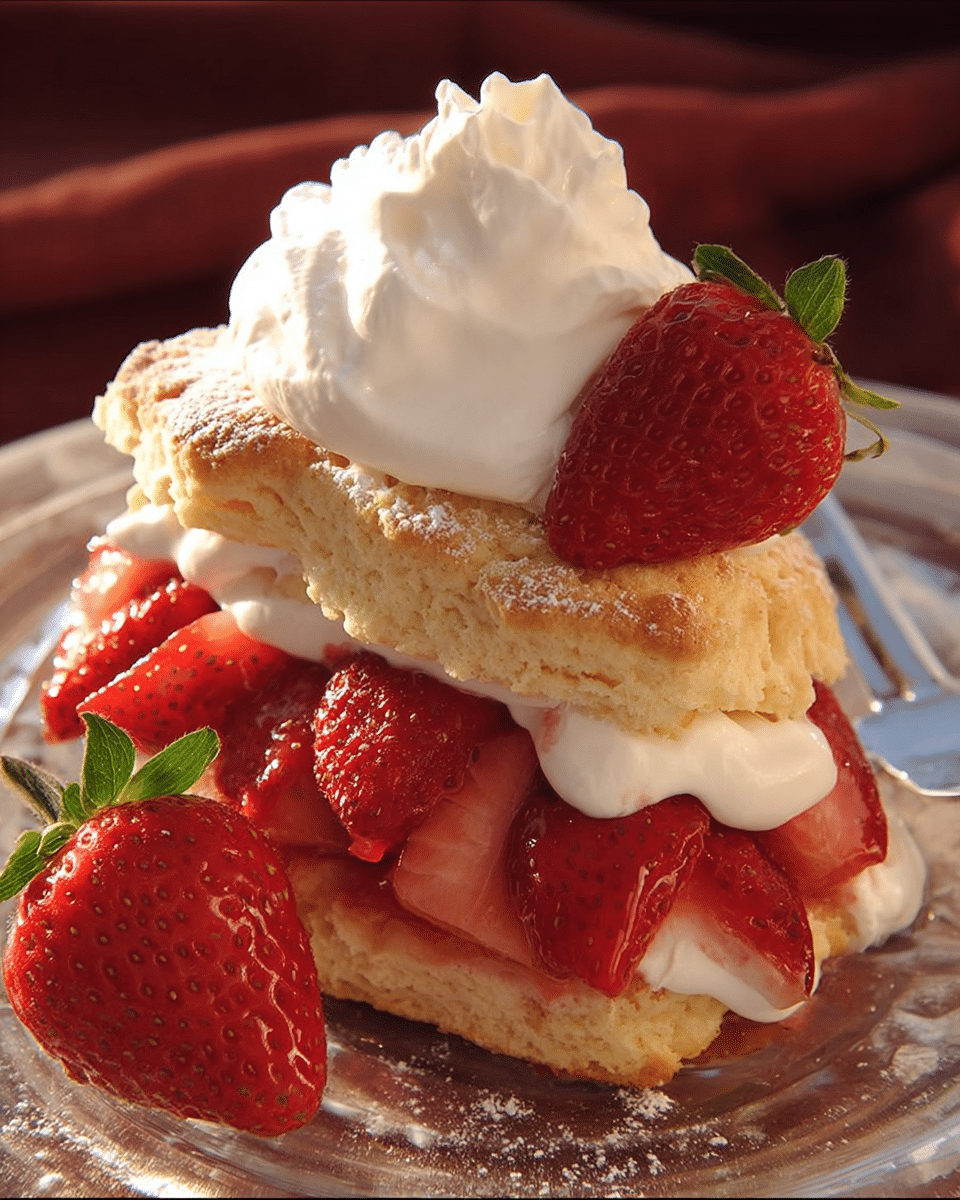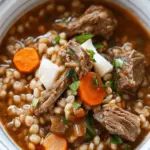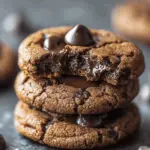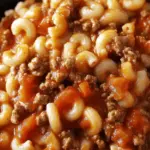The aroma of warm butter and a hint of nutmeg fills the kitchen as this old-fashioned shortcake bakes to golden perfection. With a texture that balances delicately between a tender biscuit and soft cake, it’s the perfect canvas for fresh summer strawberries and clouds of whipped cream.
A staple of nostalgic summer desserts, this recipe is simple yet satisfying, capturing the comforting flavors of a time-honored classic. Whether you’re baking for a gathering or a quiet treat at home, this shortcake will win hearts with every buttery bite.
Full Recipe:
-
2 cups all-purpose flour
-
1 cup white sugar
-
4 teaspoons baking powder
-
½ teaspoon salt
-
¼ teaspoon ground nutmeg (optional)
-
½ cup cold butter, cubed
-
⅓ cup milk
-
1 large egg
Directions:
-
Preheat your oven to 450°F (230°C) and grease an 8-inch baking pan.
-
In a large bowl, sift together the flour, sugar, baking powder, salt, and nutmeg.
-
Cut in the cold butter using a pastry blender or two knives until the mixture resembles coarse crumbs.
-
In a separate bowl, beat together the milk and egg.
-
Stir the milk and egg mixture into the dry ingredients just until blended—do not overmix.
-
Press the dough (it will be thick) into the prepared baking pan evenly.
-
Bake for about 15 minutes, or until golden brown.
-
Let the shortcake cool in the pan for 10 minutes before transferring to a wire rack to cool completely.
-
Slice and serve with macerated strawberries and fresh whipped cream for a classic summer dessert.
Prep Time: 10 minutes | Cooking Time: 15 minutes | Total Time: 25 minutes
Kcal: 327 kcal | Servings: 8 servings
The Timeless Charm of Old-Fashioned Shortcake
Old-Fashioned Shortcake holds a special place in the hearts of many dessert lovers. Its rustic appeal, simple preparation, and versatility make it a timeless favorite across generations. Unlike the mass-produced sponge cakes found in grocery stores, true shortcake boasts a buttery, biscuit-like crumb and a rich, slightly sweet flavor that pairs beautifully with macerated strawberries and clouds of whipped cream.
This traditional recipe isn’t just about dessert—it’s about family memories, summer celebrations, and the art of baking from scratch. Let’s explore what makes this classic dessert so beloved, why it continues to endure, and how you can bring its charm into your kitchen.
A Brief History of Shortcake
The origins of shortcake can be traced back to Europe, with English cookbooks in the 16th century referencing early versions of the dish. The name “shortcake” refers to the use of “shortening” in the dough—traditionally butter or lard—which gives the final product its tender, crumbly texture. As settlers brought recipes to North America, shortcake evolved into a staple of American baking, especially in regions where strawberries flourished.
By the 19th century, strawberry shortcake had become a popular dessert served during spring and summer harvests. Its appeal grew not only because of its seasonality but also because it offered an ideal balance of sweet fruit, rich cream, and buttery cake. Today, this dish remains a signature treat for Fourth of July gatherings, garden parties, and any occasion that calls for a classic dessert.
What Makes a Shortcake “Old-Fashioned”?
The term “old-fashioned” isn’t just nostalgic—it signals authenticity. An old-fashioned shortcake is made with pantry staples like flour, sugar, baking powder, butter, milk, and eggs. It’s typically prepared as a single cake or biscuit, split horizontally and layered with strawberries and whipped cream.
Unlike modern spongecake-style “shortcakes” often made with synthetic ingredients or stabilized whipped toppings, the old-fashioned version is hearty and rustic. It’s also more flexible in texture: somewhere between a scone and a biscuit, but tender enough to melt in your mouth.
The optional addition of nutmeg in this recipe gives it a warm, aromatic depth. Many home bakers also like to add vanilla extract or citrus zest, though the original version relies on simple, bold flavors and top-quality ingredients.
The Texture and Flavor Profile
An ideal old-fashioned shortcake should have a golden crust and a soft, slightly dense crumb. The crumb isn’t meant to be fluffy like a sponge cake, but instead, rich and slightly crumbly. This texture allows it to absorb the juices from the fruit without falling apart or becoming soggy.
The flavor profile is subtly sweet, buttery, and slightly savory from the salt and baking powder. When served with tart-sweet strawberries and airy whipped cream, the contrast of flavors and textures creates an unforgettable dessert experience.
Baking Science: Why Technique Matters
The success of shortcake largely depends on technique. Cutting the butter into the flour mixture until it resembles coarse crumbs is crucial for achieving that desired tender crumb. Overmixing the dough can activate too much gluten, resulting in a tougher cake.
Additionally, the high baking temperature in this recipe—450°F (230°C)—creates a beautiful crust while allowing the interior to bake quickly. This contrasts with cakes that bake low and slow for fluffiness. Instead, shortcake benefits from a quick rise and a golden finish.
Letting the shortcake cool slightly before cutting also ensures it maintains its structure. Served warm or at room temperature, it pairs wonderfully with cold toppings, creating a balance in temperature and texture that elevates each bite.
Serving Suggestions and Pairings
Though strawberries are the most traditional companion, shortcake can be paired with various fruits. Blueberries, raspberries, peaches, blackberries, and even poached pears make delicious toppings. For a twist, try grilled stone fruit, compotes, or a drizzle of citrus syrup.
Whipped cream is the classic topping, but mascarpone cream, sweetened crème fraîche, or vanilla ice cream also make luxurious alternatives. A light dusting of powdered sugar or a sprig of mint can enhance the presentation for special occasions.
For an indulgent brunch, consider serving the shortcake with a scoop of clotted cream and a fruit compote. It also makes a stunning centerpiece for a garden party or summer barbecue, particularly when layered and presented as a stacked cake.
Why It’s Still a Perfect Dessert Today
In an age of elaborate desserts and complex pastries, there’s something refreshingly honest about shortcake. It’s quick to prepare, doesn’t require special equipment, and rewards you with rich, nostalgic flavors in every slice.
Home bakers appreciate that the recipe is adaptable—swap nutmeg for cinnamon, use buttermilk instead of milk, or add a splash of vanilla to personalize it. It’s budget-friendly, accessible, and designed for celebration without stress.
Its rustic appearance only adds to its charm. While some desserts are fussy or delicate, shortcake welcomes imperfection. It encourages connection, whether you’re baking with kids, sharing with neighbors, or simply treating yourself to a sweet moment.
Tips from Experienced Bakers
Many seasoned bakers suggest adjusting the milk content depending on your flour and local humidity. Some increase it to ½ cup or more for a softer dough, while others recommend baking at a slightly lower temperature—such as 375°F—for a longer period to ensure even cooking.
Adding vanilla extract or citrus zest to the batter can give the cake more depth. Likewise, letting the sliced strawberries rest in a tablespoon of sugar for 20–30 minutes helps them release their juices, creating a syrupy topping that perfectly complements the shortcake.
Some bakers also divide the batter into muffin tins or shape it into biscuits for individual servings. This variation makes the dessert easier to serve at events or portion for guests.
Frequently Asked Questions
Can I make the shortcake ahead of time?
Yes! The shortcake can be baked a day in advance. Store it tightly wrapped at room temperature, and slice just before serving. If you’d like to serve it warm, reheat in a low oven for a few minutes.
Can it be frozen?
Absolutely. Once cooled, wrap the cake tightly in plastic wrap and foil, then freeze for up to one month. Thaw at room temperature before serving.
Can I make it gluten-free?
You can substitute a 1:1 gluten-free flour blend designed for baking, though results may vary slightly. Adding a touch of xanthan gum may help improve texture if it’s not included in your flour mix.
Is the nutmeg necessary?
No, the nutmeg is optional. It adds a subtle spice note but can be omitted or replaced with cinnamon, lemon zest, or vanilla extract depending on your taste.
Conclusion: A Slice of Simplicity and Nostalgia
Old-Fashioned Shortcake is more than a dessert—it’s a reminder of how the simplest ingredients can come together to create something deeply satisfying. It embodies the spirit of homemade cooking, where tradition meets taste and every bite tells a story.
Whether you serve it at a picnic, a dinner party, or a quiet evening at home, this shortcake brings warmth and sweetness to any table. It’s adaptable, quick, and delicious—a true testament to the enduring beauty of classic recipes.
Let it become your go-to summer dessert or your new holiday favorite. However you enjoy it, Old-Fashioned Shortcake will always offer a taste of home, love, and comfort—one golden slice at a time.






